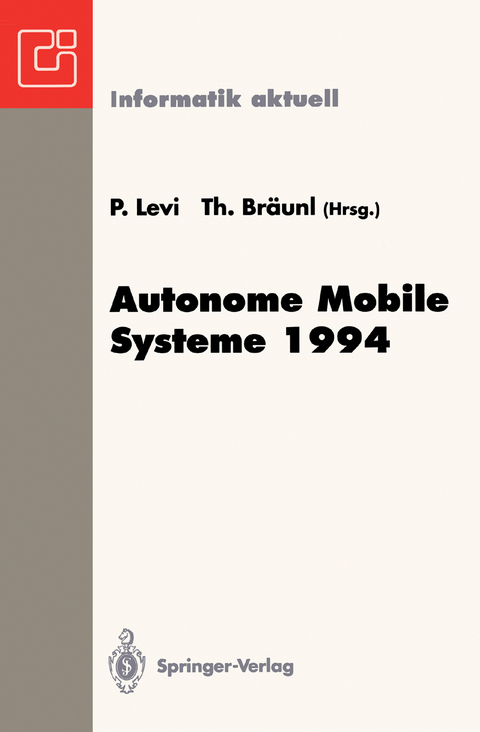
Autonome Mobile Systeme 1994
Springer Berlin (Verlag)
978-3-540-58438-4 (ISBN)
Paul Levi is Full Professor for Informatics in the Institute for Parallel and Distributed Systems of the University of Stuttgart, Germany. He graduated in physics and computer science and became a senior research scientist in informatics and robotics, and Head of the Department of Technical Expert Systems and Robotics at the University of Karlsruhe. In 1988 he was appointed Professor at the Technical University of Munich, and scientific member of the Bavarian Center for Knowledge-Based Systems. Later on he served as Director of the Institute for Parallel and Distributed High Performance Computers at the University of Stuttgart. He is Member of the Management Board of the Centre for Computer Science (FZI) and Director of the Division Intelligent Systems and Production Engineering (ISPE), Karlsruhe, Germany. Paul Levi's main research fields include computer vision, robotics, distributed AI and multi-agent systems. He has authored and co-authored both textbooks and monographs.
Bräunl is Associate Professor at the University of Western Australia, Perth, where he founded and directs the Mobile Robot Lab and is also Director of the Centre for Intelligent Information Processing Systems (CIIPS). Professor Bräunl received a Diploma in Informatics in 1986 from Univ. Kaiserslautern, an MS in Computer Science in 1987 from the University of Southern California, Los Angeles, and a PhD and Habilitation in Informatics in 1989 and 1994, respectively, from Univ. Stuttgart. He has worked in the past for BASF and Daimler Chrysler and has founded a company for innovative mobile robot design. Professor Bräunl s research interests are robotics, vision, graphics, and concurrency. He is author of several research books and textbooks and has developed the Eye Bot mobile robot family.
Lauf-, Schwimm- und Flugmaschinen.- Rohrkletterer mit acht Beinen.- Reaktive Steuerung einer Laufmaschine mittels Neuronaler Netze veränderlicher Topologie.- Entwicklung eines Sensorsystems zur Führung autonomer mobiler Unterwasser-Roboter.- TUBROB - Ein autonom fliegender Roboter.- Sensorik.- Freie Navigation autonomer Fahrzeuge.- Positions- und Orientierungsbestimmung von bewegten Systemen in Gebäuden durch Korrelation von Laserradardaten.- Einsatzmöglichkeiten eines korrelativ optischen Meßverfahrens zur berührungslosen Messung des Geschwindigkeitsvektors bei Flurförderzeugen.- AMOS: Selbständige Generierung bedeutsamer Wahrnehmungsklassen durch ein autonomes System.- Bildverarbeitung für mobile Systeme.- Axiales Motion Stereo zur Abstandsmessung für mobile Roboter.- Robuste videobasierte Identifizierung von Hindernissen und Werkstücken sowie die Bestimmung ihrer räumlichen Lage.- Sequentielle Schätzung von Sensorpositionen aus Bildsequenzen für Robot Vision Anwendungen.- Ein interagierender Interpretationsansatz für die Verkehrsszenenanalyse.- Mobile Manipulation.- Mobile Manipulation für autonome Mehrmanipulatorsysteme.- Lernen und Adaption bei der Steuerung zweier Roboterarme.- Aufgabentransformation und Aufgabenplanung für ein autonomes mobiles Handhabungssystem in einer Fertigungsumgebung.- Kosten-Nutzen-optimale Verbesserung kollisionsfreier Roboterbewegungen mittels Polygon-Manipulation.- Multi-Agentensysteme.- A Testbed for the Development of DAI Applications.- Implementing Reactive Algorithms on a Cellular Control Architecture.- Bewegungssteuerung.- Learning Control and Localisation of Mobile Robots.- Steuerung lokaler Fahrmanöver durch direkte Kopplung abbildender Sensorik an ein künstliches neuronales Netz.- Automatisches Einparken.-Kooperative Systeme.- Situationsabhängige Einsatzplanung kooperierender aktiver Sensoren auf einem mobilen Robotersystem.- Einfluß des Spielraums auf die Planungsqualität bei verteilten, kooperativen Planungsverfahren.- Architektur und Ziele der Kooperativen Mobilen Robotersysteme Stuttgart.- Hinderniserkennung und Wegeplanung.- Benutzerspezifische Wegplanung für omnidirektionale und kinematisch beschränkte Rollstühle.- Hindernisdetektion durch Real-Zeit-Auswertung von optischen Fluß-Vektoren.- Berücksichtigung von Selbstlokalisierung und Landmarkenaufbau bei der Bahnplanung.- Serviceroboter.- Flexible Automatisierung im Mauerwerksbau.- ATHENA: Mobile Roboter für Mülldeponien - Bewegungsplanung für nichtholonome mobile Roboter.- Automatisierte Mauerwerksfertigung mit mobilen Robotern: Neue Herausforderungen für die Steuerungs- und Sensortechnik.- Simulation.- Mikroskopische Simulation abstandsgeregelter Fahrzeuge.- Automatische Online-Generierung von Handhabungsprogrammen mit der 3D-Simulation.- Autorenverzeichnis.
| Erscheint lt. Verlag | 28.9.1994 |
|---|---|
| Reihe/Serie | Informatik aktuell |
| Zusatzinfo | IX, 361 S. 109 Abb. |
| Verlagsort | Berlin |
| Sprache | deutsch |
| Maße | 155 x 235 mm |
| Gewicht | 570 g |
| Themenwelt | Informatik ► Theorie / Studium ► Künstliche Intelligenz / Robotik |
| Informatik ► Weitere Themen ► CAD-Programme | |
| Schlagworte | Algorithmen • Architektur • Automatisierung • Autonome mobile Systeme • Genom • Information • Informationsverarbeitung • Robotersysteme • Schnitt • Serviceroboter • simula • Simulation • Sprache • Steuerung • Wirkung |
| ISBN-10 | 3-540-58438-2 / 3540584382 |
| ISBN-13 | 978-3-540-58438-4 / 9783540584384 |
| Zustand | Neuware |
| Haben Sie eine Frage zum Produkt? |
aus dem Bereich


